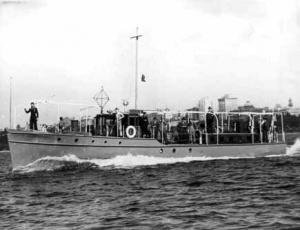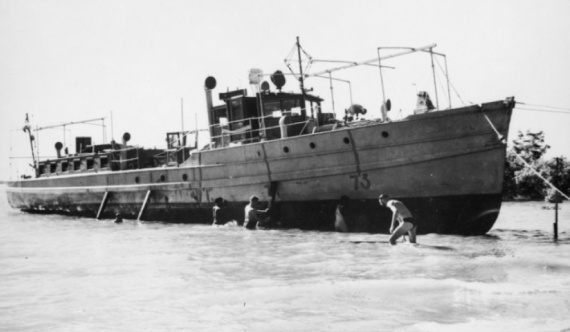HMAS Kuru
| Type |
Wooden motor vessel |
|---|---|
| Pennant |
83 |
| Commissioned |
8 December 1941 |
| Decommissioned |
22 October 1943 |
| Dimensions & Displacement | |
| Displacement | 55 tons |
| Length | 76 feet 2 inches |
| Beam | 13 feet 6 inches |
| Draught | 8 feet 6 inches |
| Performance | |
| Speed | 13 knots |
| Propulsion | |
| Horsepower | 130 HP |
| Armament | |
| Guns |
|
| Other Armament | 2 x depth charge chutes |
| Awards | |
| Battle Honours | |
Built at Balmain, Sydney, by J Beattie and Sons in 1938, Kuru was initially employed by the Northern Territory Administration on customs and police patrol duties. Her name was an aboriginal word for 'The Eye'. With war looming she was requisitioned for RAN service as a tender to HMAS Platypus, and commissioned on 8 December 1941. Before commissioning she was also used on various occasions in connection with the Coast Watching organisation around the Northern Territory coast and nearby islands.
On 31 May 1942, under the command of Lieutenant Joe Joel, RANVR, Kuru inaugurated the naval supply run between Darwin and Betano in Timor (Operation HAMBURGER), delivering men and supplies to Sparrow Force. This force had been engaged in guerrilla warfare against the Japanese, since the enemy had occupied Timor in February. Air supply had been attempted, but proven too hazardous in the face of Japanese air superiority. Over the next six months Kuru made eight trips on the 'Timor Ferry Service'. To avoid detection all loading and unloading in Timor was done during the hours of darkness.
On 13 June 1942, Kuru picked up a downed pilot at Daly River, and then on 15 June picked up another at Bynoe Harbour. On 29 June 1942 she proceeded to Beco, fifty miles east of Betano, to reconnoitre alternative landing and embarkation points returning to Darwin on 3 July. Three days later Kuru proceeded to Suai with stores, returning to Darwin on 10 July with approximately ten evacuated personnel. On 15 July Kuru proceeded to Suai with three Army personnel belonging to the 'Z' Special Unit (Operation LIZARD I) and five tons of stores returning to Darwin on 19 July with a further ten evacuees. On 31 August Kuru proceeded to Timor landing another four 'Z' Special Unit personnel and a ton of stores at Beco, thence Betano where she unloaded four personnel and five tons of stores (Operation LIZARD II). She returned to Darwin on 4 September carrying a Portuguese official, his wife and child, and some Army personnel. On 8 October Kuru proceeded to Aliambata in Timor with Army personnel and stores, returning to Darwin with evacuees. On 18 November Kuru, now commanded by Lieutenant JA Grant, RANR(S) , proceeded to Betano, landed stores, then reconnoitred Kelan River and Kicras Village, returning to Darwin on 22 November.
On 29 November Kuru proceeded to Betano and embarked almost 80 men, women and children, mostly Portuguese evacuees. She transferred them to the corvette HMAS Castlemaine on 1 December, and then returned to Betano with HMAS Armidale to withdraw and replace troops. Before completing the mission Kuru and Armidale became separated and both were subjected to enemy air attack. Over seven hours Kuru was attacked by some 44 aircraft which between them dropped more than 200 bombs. In one attack the assault boat that was being towed behind received a direct hit and vanished. Shrapnel penetrated Kuru's hull, wounding one officer and two ratings and damaging her engines. By nightfall Kuru's ammunition was almost exhausted, and ordered to return to Darwin she arrived safely on 3 December. Armidale was not so fortunate and was sunk with heavy loss of life.
On 27 January 1943 Kuru proceeded to the Wessel Islands to pick up the survivors of HMAS Patricia Cam. The remainder of her service was on patrol and boom defence work in and around Darwin.
Kuru paid off on 22 October 1943 when she sank alongside the floating dock during a heavy storm. She was recovered the same day but was so badly damaged that she never recommissioned. During 1945 she was blown ashore during another heavy storm and became the home of a hermit.
|
Assumed Command
|
Commanding Officer |
| 1942 | Lieutenant Joe Joel, RANVR |
| 1942-43 | Lieutenant John A Grant, RANR(S) |
Further reading
- 'Trying To Be Sailors', John Leggoe, Perth, St George Books, 1983.




